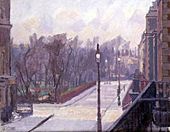Camden Town Group
The Camden Town Group is a group of English postimpressionists that in the years 1911 to 1913 in the studio of the painter Walter Sickert in the district of Camden Town in London met.
history
In 1908 the art critic Frank Rutter founded the Allied Artists Association (AAA) . It was independent of the artist groups of the Royal Academy and modeled after the French Salon des Indépendants . Many of the artists who formed the Camden Town Group exhibited their work there.
Members of the Camden Art Group included Walter Sickert , Harold Gilman , Spencer Frederick Gore , Lucien Pissarro (the son of the French impressionist Camille Pissarro ), Wyndham Lewis , Walter Bayes , JB Manson , Robert Bevan , Augustus John , Henry Lamb and Charles Ginner .
The group's influences included Vincent van Gogh and Paul Gauguin , whose work is clearly reflected in the work of the entire group. Her depiction of London before and during World War I is of both historical and artistic interest.
The picture in the cinema of Malcolm Drummond was because of his claustrophobic special attention mood. It forms an interesting counterpart to the work of Sickert, who painted many raudy-like Music Hall scenes, including the Gallery of the Old Mogul , in which he also portrayed the film audience. Sickert's Ennui from 1914 is often considered the masterpiece of this group with its portrayal of boredom and apathy in the style of Flaubert and others.
The group organized an exhibition of Cubist and Post-Impressionist painting.
Exhibitions
A major retrospective of the group's work was shown at Tate Britain in London in 2008 .
See also
literature
- Robert Upstone. Modern Painters: The Camden Town Group . Exhibition catalog, Tate Britain, London 2008 ISBN 1-85437-781-7
Web links
- The Camden Town Group in Context Project at Tate Online with information on artists, works, history and reception
- Dealing joyously with gross material facts James Beechey on the Camden Town Group

